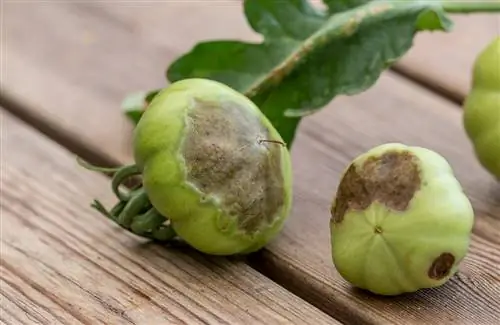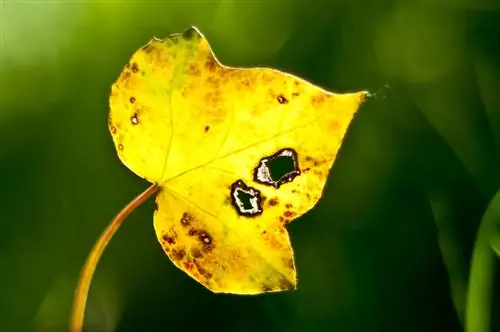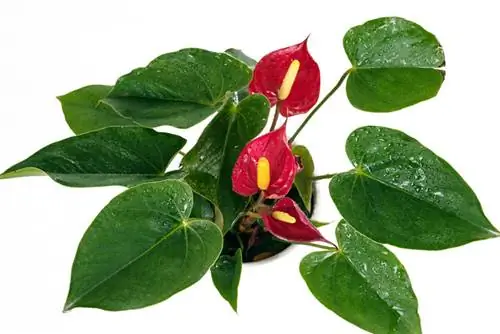- Author admin [email protected].
- Public 2023-12-16 16:46.
- Last modified 2025-06-01 06:02.
Brown to black spots on tomato fruits and leaves are not always a reason to give up tomato harvesting. Infected plants can usually be easily treated.
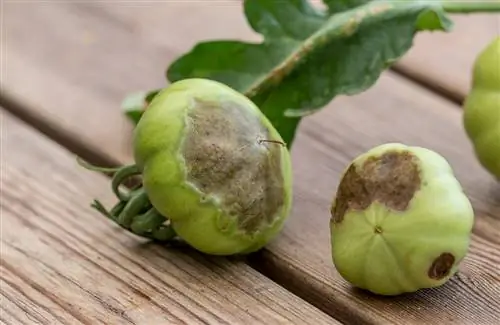
What causes brown spots on tomatoes?
Brown spots on tomatoes can be caused by diseases such as blossom end rot, late blight or blight. Treatment options include adequate calcium intake, avoiding splashing water, and regularly rooting out and fertilizing the plants.
Which diseases cause brown spots on tomatoes?
Depending on which part of the plant spots appear, they indicate a nutrient deficiency or incorrect care. The most common brown spot diseases include blossom end rot and late blight. If tomato plants are infected, the progression can only be slowed down but not stopped through proper care. Tomato plants with brown rot should be completely removed and no longer eaten.
Brown spots on tomato fruits
Brown spots on tomato fruits often scare amateur gardeners. The rotten spots can be an indication of serious tomato diseases, which sometimes result in an entire crop failure. Some diseases weaken the plants so much that they die before the first crop is produced.
Blossom end rot, late blight or blight?
It is already written in the Bible: “You will recognize them by their fruits.” Because if you look closely at the tomatoes themselves, you can tell exactly which disease the plant is suffering from. Blossom end rot forms brown spots at the bottom of the former flower base, while dry spot disease mainly affects the upper areas. However, late blight on tomatoes generally causes large brown spots to form.
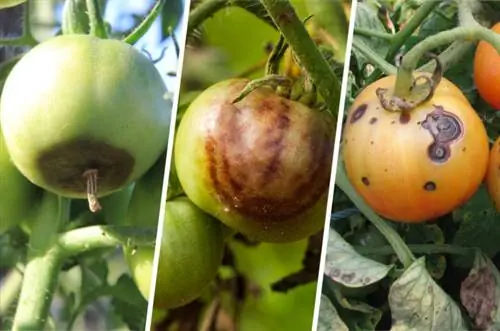
Blossom end rot
Blossom end rot is easy to recognize and easy to distinguish from other diseases. It is more likely to occur in new planting sites and inexperienced hobby gardeners than in experienced tomato professionals. Because blossom end rot is not a bacterium, but rather aundersupply of the plant nutrient calciumIf the interaction between watering, fertilization and the pH value of the soil is correct, deficiency symptoms usually do not occur.
Causes: Neither fungi nor bacteria are causes of blossom end rot. Instead, the plant lacks the mineral calcium, which is responsible for the structure and stability of the cell walls in tomato fruits. If there is a lack of the important nutrient, the cell walls collapse.
Symptom: Small, dark dots at the bottom of the fruit appear at the beginning of a deficiency. These spots become larger and watery-glassy and can take up the entire lower half of the tomato. The damage is completed by a bulging of the flower end, which becomes leathery and rotten. Ripe and unripe fruits can be affected.
Prevention: To avoid blossom end rot, the soil should be sufficiently supplied with calcium. Organic fertilization from compost and manure is sufficient in most cases. The use of nitrogen should not be exaggerated. The pH value of the soil is ideally 6.5 to 7. If the value is too acidic, rock dust can make the soil more alkaline and at the same time provide calcium.
Blight and brown rot
Early blight (Phytophthora infestans) is afungal disease that usually originates from infected potato plants Damp and cool summer months promote the proliferation of fungal spores. While tomatoes grown outdoors are more often affected, greenhouse tomatoes suffer less often from late blight due to the better climate conditions.
Causes: The fungus is found in almost every soil and especially on potato tubers that are intended for planting. As a result, Phytophthora infestans spreads through the soil around the potato and can reach the lower leaves of the tomato through splashing water when watering. There the fungus enters the plant and multiplies rapidly.
Symptom: At the beginning of an infection, the leaves and stems are covered with gray-green spots that are blurred. After some time these turn brown to black. A white down often forms on the underside of the leaves. Even the stem can have brown-black spots. The fruits develop brown, concave rotten spots, which are mainly found on the upper half of the tomato. The flesh has hardened under the rotten spots.
Prevention: First and foremost, tomatoes should be planted at a sufficient distance (60-70 cm) from each other and as far away from potatoes as possible. In addition, to prevent the rapid multiplication of the fungus, dryness and ventilation should be ensured. Regular cleaning and a rain cover are ideal for this. Disinfect pots and trellises with boiling water after each season so that no spores are carried over into the following year.
drought spot disease
Another fungus that affects tomatoes in the home garden is Alternaria solani or Alternaria alternata. Like most ascomycetes, the blight blight pathogen likes a moist climate; but in contrast to late blight, warm temperatures. The fungus or its spores are naturally found in the soil and survive even long fallow periods.
Causes: Alternaria infects tomato plants either via the soil through splash water or via the roots, via climbing aids or directly via the tomato seeds. Incorrect watering or too little fertilizer weakens the plant and makes it more susceptible to infection. Humid and warm climates significantly favor the reproduction of the fungus.
Symptom: The leaves of an infected plant have gray-brown spots, with the edge appearing yellowish. The dry areas also appear in an irregular shape and become larger. At the same time, slightly different colored rings form in the spots. Over time, the leaves curl up and eventually fall off. The dry spot disease is noticeable on the fruits through brown-black spots at the base of the fruit stalk. The areas are slightly curved inwards, rather hard and show a similar ring structure.
Prevention: Seeds from infected plants should not be used for growing next year because they are already infected. The motto also applies here: prevent splashing water on the leaves. Good ventilation helps the dew dry. Trellises and pots must be cleaned thoroughly after each season. A field horsetail extract can be sprayed onto the leaves as a strengthening agent or added to the irrigation water.
Brown spots on tomato leaves
Brown spots often appear on other parts of the plant: dry spot disease, leaf spot disease and bacterial wilt cause brown spots on tomato leaves. But deficiency symptoms can also be behind leaf discoloration. As a rule, leaves with noticeable spots should be removed to be on the safe side.
Symptoms of deficiency in tomato plants
An imbalance in nutrients can be a cause of brown spots on leaves. A nitrogen deficiency initially manifests itself on the lower leaves, where they first turn yellow and then brown. If there is a potassium deficiency, the edges of the leaves turn brown and dry out. Light brown spots that spread to the entire leaf and only the leaf veins shine through green indicate a magnesium deficiency.
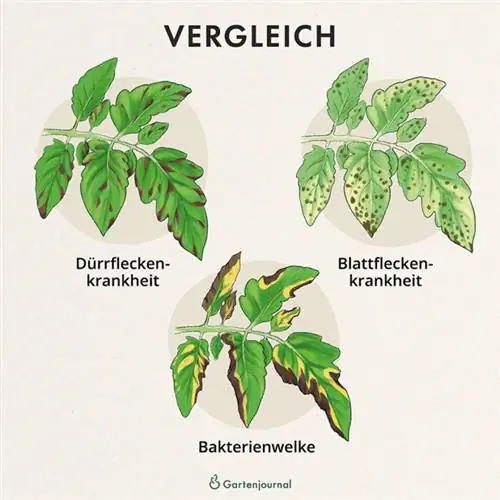
drought spot disease
Brown spots on tomato leaves can be an indication of fungal blight disease. A detailed description of the causes and symptoms as well as tips for prevention can be found in the paragraph above.
Leaf spot disease
An infection with the leaf spot pathogen is usually indicated if the tomato plants are in close proximity to the celery. The Septoria fungus specializes in root vegetables, but may also attack tomatoes. Therefore, celery - like potatoes - should be planted far away from the fruiting vegetables.
Causes: As with most fungal diseases of tomatoes, the infection occurs via the soil and splash water or through already infected seeds. Persistent moisture in the air and on plant parts drives the development and reproduction of the fungus. Compared to the other diseases mentioned, leaf spot is rather rare.
Symptom: Starting from the lower leaves, the damage caused by the fungal attack is shown by watery spots that are dark brown in color. The spot is surrounded by a yellow ring. After a while the leaf dies. On closer inspection, spore containers (black dots) can be seen in places on the underside of the leaves. The growth of the plant is sometimes severely restricted, which is consequently reflected in a reduced yield.
Prevention: Above all, he althy seeds and enough distance from celery plants prevent leaf spot disease. Thinning and a rain roof improve ventilation and protect against persistent moisture, thereby inhibiting fungal growth. Clever watering methods like an Olla prevent contaminated splashing water. A treatment with field horsetail can also strengthen the tomato and help combat it.
Bacterial wilt
Brown spots on the leaves can also be an indication of a bacterial infection. The pathogen is identified as “Clavibacter michiganensis Smith ssp. michiganensis (Smith) Davies et al.” not only has an absurdly long scientific name, but primarily endangers the entire tomato crop.
Causes: The bacterium enters the plant through injuries to the epidermis, but also through stomata. The pathogen feels most comfortable on young plants and at high temperatures between 26 and 28 °C. Contaminated seeds and tubers are the main ways the bacterial wilt pathogen spreads. Splashing water can spread the disease to surrounding plants. The bacterium can survive on inanimate objects for at least a year.
Symptom: Brown spots appear on the leaves between the leaf veins, which are more reminiscent of burns from a burning glass than of rotten spots. Then the undersides of the leaves turn yellow and the channels of the shoots become brownish and deformed. Without countermeasures, the leaves turn brown and die.
Prevention: To avoid infection with the bacteria, the gardener should make sure to keep the soil as loose as possible and to plow the soil well and deeply after and before the tomato season. Otherwise, spray-free watering, thinning and sufficient fertilization apply so that the plant retains its strength.
FAQ
Are tomatoes with brown spots still edible?
As a rule, tomatoes with brown rotten spots should no longer be consumed. Late blight, brown blight and bacterial wilt make the fruit inedible. The experts are unsure about blossom end rot. Only if the brown spots are caused by leaf spot disease is it safe to eat.
Can infected tomatoes or leaves go into the compost?
Plants and fruits that develop brown spots due to blossom end rot can be put in the compost. All other causes are either bacterial or fungal and must be burned or disposed of with residual waste. Otherwise the pathogens will survive and multiply in the compost.
What causes brown spots on tomatoes?
Brown spots on tomatoes can be due to a calcium deficiency. But bacteria or fungi are often to blame for the brown rot spots.
What can be done about brown spots on tomatoes?
It is best to immediately remove tomatoes that have brown spots. This prevents the disease from spreading. Then the cause of the stains must be examined carefully in order to take effective countermeasures.

